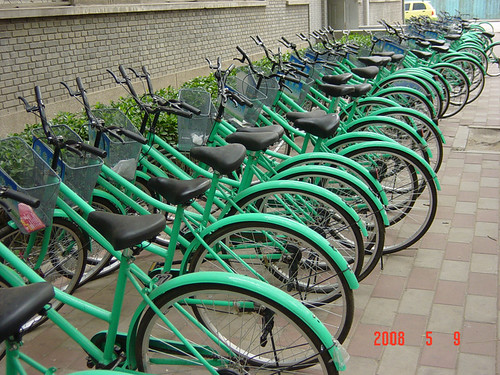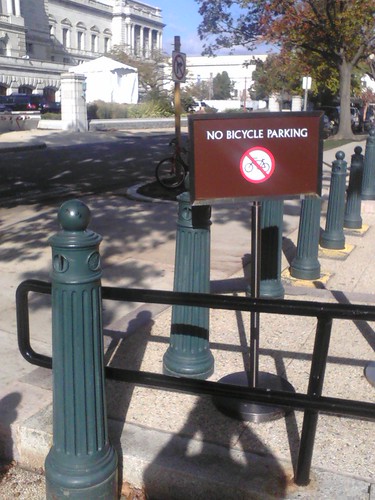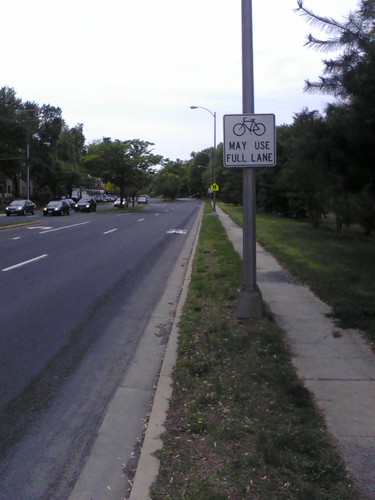When the first diamond frame bicycles became popular in the 1890s they were often called "wheels" - the national cycling association was called the "League of American Wheelmen." We have moved from "wheels" to "bikes," but the bicycles have remained remarkably the same over more than 100 years - elegant in their efficiency and simplicity. And many of the issues that we think are new? They were around then too.
Sunday, October 2, 2011
500 Hurt in New York City by Bikes - Good? Bad?
The first study he quotes compares soot accumulation in the lungs of five (5!) cyclists who commute by bike in London with Londoners who don't. The cyclists had higher levels of black carbon in their lungs. When I think of something as an "potent urban menace" I am thinking it means to other people and not to themselves. But it says cycling is bad, so he tosses that into his article.
The second study has been reduced by the Internet (and the Wall Street Journal) to "500 pedestrians hurt by bikes in NYC a year." The study, done at Hunter College, was more nuanced that that and tried to determine if more or fewer pedestrians were injured by cyclists over a four year period - their conclusion was that despite more cycling and cycling infrastructure, the number has dropped (slightly). So this is a good metric - that is, even if we want to think that cyclists are a potent urban menace, it seems to be declining, or anyway not growing at the rate that cycling is growing. No one suggests that the 500 figure is good but there are questions such as, "compared to what?" and "is it going up or down?" that these articles typically ignore.
Different publications draw different conclusions - the New York Daily News takes the view it suggests a "need for tougher enforcement" which I guess is step beyond the Wall Street Journal position. But a physical fitness advocacy group takes the position that this is good news since the number isn't growing - "The city says that while bike use is up, the total number of accidents is stable. According to a Hunter College study, some 500 pedestrians are hurt each year by cyclists. At Bike New York, there is nothing but optimism." Kind of oddly put, but anyway.
This takes the "is the glass half full or half empty to new heights (or lows, depending on your point of view). And it does nothing for confidence in the Wall Street Journal.
Another point of view is provided by the trailer for the new bike messenger movie set in NYC - it makes it look like it is the messengers and the taxi drivers who are having dramatic traffic interactions.
Friday, July 8, 2011
More Accurate Video of Dutch Cyclists
The speeded-up version of Dutch commuters that received so much attention
The speeded up version does reduce the "boredom factor" and makes it clear more quickly how many cyclists are moving to and fro in such a business-like way.
Now however the blogger has released a real-time version, which I think makes the same points just as nicely.
Real-time video of same intersection
At about 45 seconds, a father (presumably) takes off from a stop with his son on a bike to his right (and daughter riding in a seat and behind him), putting his hand on his back to help get him up to speed. Don't see much of that here.
The mix of bikes is interesting, too, and easier to observe at the slower speed. Bikes in the Netherlands are obviously more about urban transportation and (much)less about sport - I saw only one or two drop handle road bikes among all these. Of course, part of that may well be that cycles are required to have a headlight and tail light and most of these bikes, used daily, have fenders (with the tail light built into the rear fender).
I find it interesting how practically everyone seems to be following the rules (or laws, I suppose). There are the occasional riders who don't stop for the light, but they are very few. And of course the sheer volume, even in real-time, makes an impression compared to the Washington DC area. Even in real time, the left turns by some of the cyclists seem almost choreographed. Of course, the real-time version takes five minutes and the speeded-up version takes only two. . .
Saturday, June 18, 2011
Florida Leads Nation . . . in Cyclists Killed by Cars
Florida leads the nation in bicycling and pedestrian fatalities. Gancarz is at least the 20th bicyclist to be killed since July while riding on area roads.According to the article, "blame" (as determined after the fact) was split evenly between drivers and cyclists.
One of the first books about travel by bike I read was by Barbara Savage, who in the 1980s went around the world with her husband by bike and wrote Miles from Nowhere. I recall that they found Florida to be one of the least friendly states for cyclists - have things not changed in 25 years? (Barbara Savage died in an accident with a truck while cycling after returning to California . . .)
Monday, June 6, 2011
Bike Event in Berlin Closes Streets, 150K Riders
Amazing.
Saturday, May 28, 2011
"Complete Streets" Video
Complete Streets: It's About More Than Just Bike Lanes from Streetfilms on Vimeo.
Very well done video about implementation of bike lanes as part of a "complete streets" strategy. Local political types, journalists, drivers, pedestrians, business owners, and bike riders all comment. Well worth watching.
This simple video makes it clear that the argument in favor of bike lanes needs to be about how everyone can benefit, not just the bike riders. That everything about the roads shouldn't be about people in cars.
Stated as though obvious (and OK) is that slowing down speeding motorists as part of the general strategy benefits everyone, even the motorists (who are no longer terrorizing pedestrians and cyclists). Narrower lanes? They slow the cars down. Islands? The encourage the motorists to stop and wait for pedestrians.
Saturday, April 16, 2011
Sir Arthur Conan Doyle on Benefits of Cycling, 1896
When the spirits are low, when the day appears dark, when work becomes monotonous, when hope hardly seems worth having, just mount a bicycle and go out for a spin down the road, without thought on anything but the ride you are taking.But did he have more to say? Yes he did.
The rest of what he had to say:
I have myself ridden the bicycle most during my practice as a physician and during my work in letters. In the morning or the afternoon, before or after work as the mood o'ertakes me, I mount the wheel and am off for a spin of a few miles up or down the road from my country place. I can only speak words of praise for the bicycle, for I believe that its use is commonly beneficial and not at all detrimental to health, except in the matter of beginners who overdo it.This quote from the physician Conan Doyle was in the spirit of this period to find medical doctors who would endorse the health benefits of cycling, or at least not condemn it. That he was a famous and clever writer was presumably a bonus.

Cycling Notes column in Scientific American issue of January 18, 1896 with full "Dr. Conan Doyle" quote in middle.
Saturday, March 26, 2011
Cross Country Cycle Road - 1896 Plan

Map for a cross country bicycle route
Taken from Washington DC Morning Times, June 7, 1896. Reflects some wishful thinking on the future of cycling in the days before automobile owners (and their allies) took over the lead in advocating for funding a good network of roads. The article's author advocates a connected network of "good roads" rather than more expensive macadamized (asphalt) dedicated "bicycle tracks" or "bicycle paths" for long distance bicycle travel.
Some quotes ~
To establish a bicycle track from coast to coast so that wheelmen can journey from New York to San Francisco as easily if not as rapidly as they now do by train. Such tours have been undertaken and partlv carried out. One man would wheel from Salt Lake Cit to Buffalo. Another, at some time, would start at Chicago and wheel to the Pacific Coast. But they seldom wanted to take the trip twice. It was too tiresome. Roads were too bad. Too many mountain paths had to be climbed, too many prairies tortured through. But I am looking into the matter so as to do away with all this.
What has hampered us more than anything in this cross country project are the wheeling [cycling] enthusiasts. These gentlemen insist upon bicycle paths and so we get nothing. A macadamized bicycle path costs in a rocky locality $15,000 per mile. Now make this same locality and use tho road that is already in it by merely improving it and the cost will not be $3,000. You can make a mile or very bad road into very good road for that sum. That is what I mean by intelligent wheeling legislation.
"Across the country in eighty days will be the wheelman's attraction a few years hence. Now it looks funny, but that is what Jules Verne's idea or "Round the World In Eighty Days" did to people years ago. Now we can belt the sphere in seventy days."Full text of article available most readably here.
Thursday, February 24, 2011
Video "Me and My Bike" (from Kenya)
Short article about the video that was produced as part of a contest to create one-minute advocacy videos in support of the environment. Besides being energetic, gives a good street-level view of that part of the world. (Uganda looks much the same - I have not been to Nairobi.)
The video apparently won the contest (http://www.1minutetosavetheworld.com/)
Friday, December 24, 2010
Bicycles Out of Favor in Beijing

Some people gave up commuting by bike because it became too dangerous on roads packed with cars, Zhang Zhuting, a member of the Ministry of Transport's legal consulting committee, said.Somehow to me this seems like a coals-to-Newcastle kind of thing, but I suppose it is different. Anyway, I think the problem in Beijing is economic and not about getting peoiple to obey rules.
Concrete measures are needed to ensure the effective operation of the public bicycling system, and the bike rental industry needs more policy support to survive, he said.
Tsinghua University law professor Yu Lingyun said many European cities, such as Paris and Amsterdam, have long run effective public bike systems.
"They have developed detailed rules and management mechanisms to maintain the system, and their residents obey the rules," Yu said. "Beijing should learn from their experiences."
Sunday, December 12, 2010
Russian Blogger Explains Cycling in Paris

Of course, it isn't perfect - a fair number of words related to cycling that the author uses don't appear in any dictionary so they are simply transliterated versions of the Russian Cyrillic ones. Most of these are understandable this way, however - the blog entry title is "Sketch of veloinfrastrukture Paris" - "veloinfrastruktura" would be "cycling infrastructure," a single word coined most likely recently in Russian. Or the word "sitibayki" - that is, "city bikes," a case (another case) where an English word/phrase has been incorporated into Russian wholesale.
This is a good, comprehensive overview of what Paris does to support cycling as an alternative means of transportation. Much of what is described is available in some (a few?) American cities, but I don't think any do all these things.
Friday, November 12, 2010
Some Russian Bike Blogs/Sites
Live Streets or Живые улицы is not just about cycling but urban issues more generally, from Ekaterinburg. Russian only.
Iron Pony First is блог о велосипедной культуре в Петербурге, о которой пока что не так много можно сказать, поэтому приветы от других велосипедных культур здесь тоже будут. That is, a blog about bicycle culture in St. Petersburg (about which there isn't much to say for now . . . ). Russian only.
Cyclepedia.ru is an online Russian biking magazine, of sorts. Only in Russian. Has section for videos and various types of bikes, such as fixed gear.
Friday, November 5, 2010
No Bike Parking, Please (Capitol Hill, LoC)

How not very friendly. At the Adams Building, Library of Congress, Washington DC (on Capitol Hill).
What they mean is that they don't want bicycles locked to the railing blocking the ramp for the disabled, but do they provide a bike rack close by? No. Do they indicate where the nearest LC bike rack is (about 100 yards away, out of sight, across the street)? No. And so on. So instead people have bikes locked to sign posts up and down the street. Could be done better.
And the sign itself actually takes up more of the relevant real estate than any bike ever did. Oh well!
Monday, October 11, 2010
More Riders, Fewer Crashes
The rationale is that as there are more cyclists, motorists realize that they must adapt to their presence and (in effect) drive more safely (relative to the cyclists, anyway).
But when there are a lot of bicyclists on the road, according to this theory, drivers take notice. They become more attentive, slow down, pass more cautiously, double-check their blind spots, expect the unexpected. They sense that the road has become a more complicated place, and adjust their behavior accordingly. As a result, the road becomes safer, presumably for everyone.
Wednesday, October 6, 2010
Cyclists in Deadly Accidents
The president of the Wisconsin Cycling Association has died from injuries suffered when he was struck by a car while bicycling Friday in Waukesha County. Jeff Littman was also a well-known bike racer and co-owner of a bike store. Authorities said the driver of the car, who wasn't injured in the crash, said the sun blinded him and caused him not to see Littman and another bicyclist.
Have to remember to be careful out there.
Tuesday, October 5, 2010
Seattle Blog Entry on anti-Bike "Culture"
You wouldn't think you'd have to explain that a human-powered, 20-pound, two-wheeled machine is vastly less expensive from every angle than a gas-powered, 4-wheeled car weighing several tons, but again, these are people who--in their rush to banish cyclists from the road, and despite the bumper stickers which spell this out--fail to consider that each bicycle is one less car to clog traffic.
The more interesting part of the blog entry is most people don't have much of a grasp of the relevant laws.
Many people don't know that it is legal to ride your bicycle on a sidewalk in Seattle--at a safe speed, and yielding to pedestrians, not yelling to them--or that cyclists can ride two abreast in the street. Seattle requires you to have a helmet, brakes, and, at night, a white light on the front of your bike with a red reflector on back. Cyclists can use crosswalks, but not heedlessly endanger pedestrians or impede traffic. Cyclists are required to use hand signals. A person in a car can't open their door to traffic (bike or otherwise) in a way that impedes traffic.
Saturday, October 2, 2010
Book on how Portland got to be Bike Central
Its small chapters outline issues such as the challenges of retrofitting streets with bike lanes, building off-street paths, adopting and enforcing bicycle parking codes and encouraging people to incorporate bicycling into their daily lives. In addition, it describes overcoming obstacles, business opposition and negative media coverage.
Even in Seattle . . .
Wednesday, September 29, 2010
Int'l Bike (or Walk) to School Month, Day ?
More information is available.
One assumes in much of the world every day is walk to school day.
Bike Box (Traffic Measure) in Seattle
I have to think about whether I think there is any real benefit or not.
One aspect is that 12th, the street where this will be in Seattle, is a fairly wide street but not very heavily used by car traffic. So it may make good sense there.
Sunday, September 26, 2010
"3 Foot" Laws to Protect Cyclists
One problem seems to be that some see a contradiction between having laws allowing bicycles to use a full lane as needed and a three foot clearance requirement - see this article about Hawaii, for example. And what is the point of dedicated bike lanes if passing vehicles must clear bicycles in them by three feet - apparently motorists are expected to give three feet of clearance then too says this article.
Sign in Arlington VA reminds motorists that bicycles are entitled to the full lane - the bicycle "may use full lane" (or may not . . . ) ~
